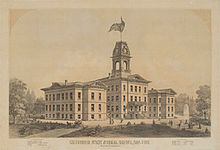
History of San Jose State University

San José State University in San Jose, California, evolved from the California State Normal School, which was a teaching college founded on May 2, 1862. Its southern branch campus evolved into the University of California, Los Angeles, in Los Angeles.

History
The school was created when the state of California took over a normal school that educated San Francisco teachers in association with that city's high school system. This school was founded in 1857 and was generally known as either the San Francisco Normal School or Minns Evening Normal School.

Although the California legislative act founding the school referred to the institution as the "Normal School of the State of California," the institution was commonly referred to as the California State Normal School. The 1870 Act that moved the school to San Jose formalized the California State Normal School name. However sometimes it was referred to as San Jose State Normal School or State Normal School at San Jose.[1]

In 1871, the school moved to Washington Square Park at Fourth and San Carlos Streets in San Jose, where San José State University is still located. The original building at Washington Square Park was completed in 1872 but burned down on February 10, 1880. It was replaced by a second building in 1881, depicted in the lithograph at right.

In 1887, the state legislature again changed the school's name, dropping the word "California" and designating the school along with its northern and southern brethren (see below) as "State Normal Schools". By the end of the 19th century, the State Normal School in San Jose was graduating roughly 130 teachers a year and was "one of the best known normal schools in the West."[2]

The school later became San Jose State University, the founding institution of the California State University system.

Other campuses
In 1881, the state legislature authorized a southern branch in Los Angeles which opened in 1882, and in 1887, a northern branch in Chico which opened in 1889. The southern branch campus was originally governed by the same board as the existing State Normal School in San Jose. This arrangement was unsatisfactory to Southern Californians, since the original point of creating a normal school was to train teachers to work in local schools and serve local needs. Therefore, in 1887, the state legislature made an important change: the southern branch and the northern branch would have their own boards of trustees. From then until 1921, the State Normal Schools were each governed by their own boards, which meant they did not function as a system in the modern sense.[3][4] The only thing the State Normal Schools had in common is that they were state-funded teacher training schools with boards of trustees appointed by the governor, but they otherwise operated with complete autonomy from each other. Additional State Normal Schools were established at San Diego in 1897, at San Francisco in 1899, and elsewhere around the state. (California's bad habit of creating new boards to solve problems continued for almost a century, until Governor Pat Brown finally cracked down in February 1961 after discovering that approximately 360 boards, commissions, and agencies reported directly to the governor.[5])

In 1919, the California State Legislature established a southern branch of the University of California and in so doing, transferred the campus of the State Normal School at Los Angeles to the new university branch. Students at the State Normal School became students of the Teachers College of the new southern branch, the direct ancestor of the UCLA Department of Education. With the exception of Los Angeles (transferred in 1919) and Santa Barbara (transferred in 1944), the State Normal Schools later evolved into the California State University system.

In 1921, the California State Legislature decreed that the remaining State Normal Schools would henceforth be known as State Teachers Colleges. The original campus became the State Teachers College at San Jose. All boards of trustees were dissolved, and all state teachers college presidents were required to report to the deputy director of the Division of Normal and Special Schools of the new California Department of Education located at the state capital in Sacramento.[6] In 1935, the teachers colleges prevailed after a three-year battle over whether they should be allowed to expand beyond vocational education to provide a broader liberal arts education, one of the traditional prerogatives of the University of California.[7] The state legislature renamed all of them to State Colleges and expressly authorized them to provide four years of liberal arts education culminating in bachelor's degrees. The new San Jose State College was no longer limited to educating teachers and later evolved into San José State University.

Athletics
After 1887 the official name of the San Jose campus was the "State Normal School at San Jose". The school's athletic teams initially played under the "Normal" identity as indicated in the 1910 football team photo on this page, but they gradually shifted to the State Normal School identity, as evidenced by images of the SNS football and basketball squads from this era. Despite the SNS identity, the school continued to be referred to as the "California State Normal School, San Jose" in official publications like the 1919 school bulletin pictured on this page. Historical archives in the Martin Luther King, Jr. Library on the San Jose State campus include a number of pieces of State Normal School memorabilia, including an "SNS" pennant.

Gallery
-
The southern branch campus of the California State Normal School, predecessor to UCLA, at its original downtown Los Angeles location
-
The State Normal School at San Jose football team in 1910. Jerseys display a large "N" for "Normal"
-
The California State Normal School bell, forged in 1881, still graces the San Jose campus
-
The California State Normal School, San Jose, catalog from 1918-1919 school year
37°20′9″N 121°52′57″W / 37.33583°N 121.88250°W[8]

Notes
- ^ Liedtke, Michael (April 22, 2015). "Lucy M. Washburn". SJSU News. Retrieved 2018-01-05.
- ^ Thomas, Grace Powers (1898). Where to educate, 1898-1899. A guide to the best private schools, higher institutions of learning, etc., in the United States. Boston: Brown and Company. p. 17. Retrieved August 17, 2012.
- ^ Douglass, John Aubrey (2000). The California Idea and American Higher Education: 1850 to the 1960 Master Plan. Stanford: Stanford University Press. p. 137. ISBN 9780804731898.
- ^ Gerth, Donald R. (2010). The People's University: A History of the California State University. Berkeley: Berkeley Public Policy Press. pp. 11–26. ISBN 9780877724353.
- ^ Blanchard, Robert (February 14, 1961). "Brown Criticized for His Super-Agency Proposal". Los Angeles Times. p. 1. Available through ProQuest Historical Newspapers.
- ^ Gerth, Donald R. (2010). The People's University: A History of the California State University. Berkeley: Berkeley Public Policy Press. pp. 31–32. ISBN 9780877724353.
- ^ Gerth, Donald R. (2010). The People's University: A History of the California State University. Berkeley: Berkeley Public Policy Press. pp. 23–24, 33–35. ISBN 9780877724353.
- ^ U.S. Geological Survey Geographic Names Information System: San Jose State University
References
- Act to Establish and Maintain a State Normal School (May 2, 1862), The Statutes of California, pp. 472–473, Benj. P. Avery, State Printer, Sacramento, 1862.
- Historical Sketch of the State Normal School at San Jose - 1862 - 1889, State Office, Supt. of State Printing, 1889.
- Act Providing for the Selection of a Site for and Construction of the California State Normal School
- Washington Square 1857-1979: The History of San Jose State University, Gilbert & Burdick, San Jose State University, 1979.
- Universities and colleges in Los Angeles County, California
- Universities and colleges in Santa Clara County, California
- California State University
- Universities and colleges established in 1862
- 1862 establishments in California
- History of the University of California, Los Angeles
- San Jose State University
See what we do next...
OR
By submitting your email or phone number, you're giving mschf permission to send you email and/or recurring marketing texts. Data rates may apply. Text stop to cancel, help for help.
Success: You're subscribed now !






